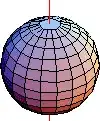How many degrees of freedom does a monoatomic gas have?
According to my Thermal Physics textbook, there are $3N$ degrees of freedom for $N$ particles because the particle is free to move in the $x$, $y$, and $z$ directions.
Why doesn't the rotation/spin of the particle count as a degree of freedom? If we treat the atom as a classical particle, can't it also rotate in the same way that the Earth rotates/spins once per day along its axis?
I also understand that there are electronic degrees of freedom but those may only come into play at higher temperatures.
For context, I am learning about the equipartition theorem. Maybe this is the reason: the spin degree of freedom does exist, but it simply doesn't come into play here because the equipartition theorem only accounts for quadratic degrees of freedom.
